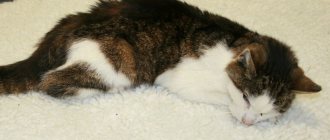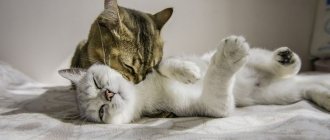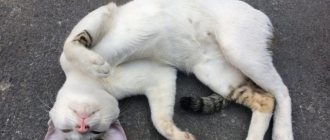Sexual maturity in a domestic cat occurs at 6 - 7 months, in a cat at 9 - 10. The period depends on the time of year, breed and individual characteristics of the body. By this age, the animal has not yet reached physiological maturity and will not be able to produce full-fledged offspring. The most suitable age for reproduction is one and a half years. Therefore, it is not advisable to breed during the first heat. A domestic cat is capable of mating and producing kittens 2–3 times a year.
Estrus appears in February - March, the next activity occurs in the summer months. Repeats after 2 weeks if pregnancy does not occur during mating. When breeding purebred animals, mating after reaching 8 years of age is not recommended.
Optimal period for first mating
The first time a cat comes into heat is between 7 and 9 months of age, sometimes it can happen a little earlier or later. In the future, it can be repeated again after 14 - 25 days.
This is influenced by the breed of the animal, as well as the living conditions and proper nutrition. However, at such an early age, the cat’s body is not yet fully formed; the growth period is not yet over. Psychologically, the animal is also not ready for procreation, so the cat should not be mated for the first time during the first heat. In some cases, this can lead to difficult childbirth, death of offspring, or further infertility of the animal.
Cats reach final sexual maturity between 1 and 1.5 years. This age is considered the most suitable for the first mating. If you are determined to start breeding kittens, then mating a cat for the first time will best take place during this period of time.
Estrus, main signs
The entire estrus period can take from 5 to 10 days. On the first and second days, the cat's behavior changes; it may become agitated, more affectionate, or aggressive. Often she begins to rub against her legs, furniture and various things. The gait may noticeably change: the hind legs are slightly bent, the tail is raised and the lower back is slightly arched. At this stage, the cat will not allow her boyfriend to approach her.
Over the next 3-6 days, the cat begins to meow loudly, calling for the cat; if you stroke her in the sacral area, she takes a certain pose. The tail moves to the side, raises the croup and falls on the front paws. During this period of sexual heat, the animal's appetite may also decrease significantly and the number of urinations of the animal may increase.
As a rule, in order to avoid exhaustion of the cat’s body, felinologists recommend breeding cats no more than three times in two years.
Puberty of a cat
The first signs of sexual maturity in a cat appear between the ages of 8 and 10 months. First of all, changes occur in the pet’s behavior:
- the kitten’s cheerfulness and playfulness may give way to more aggressive actions;
- in the evening and at night, the cat meows annoyingly or even screams heartbreakingly, thus inviting females;
- begins to mark the territory with a strong-smelling secret, thereby indicating that this is his possession;
- tries to use various soft things to satisfy his sexual needs.
The first mating of a cat should occur only after he has fully reached puberty.
The onset of this period may vary slightly in different breeds, on average it is from 1.3 to one and a half years old. Unlike cats, cats are ready to mate all year round, but with the arrival of spring the desire to procreate becomes stronger.
In order for the mating of a cat to be successful for the first time, it is better to select an experienced partner for him. However, even a couple of untied animals often cope with this task quite well. Do not forget that the reproductive instinct is very strong and is one of the basic natural needs.
Why does a cat still “flow” after mating?
In fact, everything is natural and natural. Usually, for several hours and even days after coitus, the female will behave restlessly, still purring, rolling on the floor and lifting her tail when any touch to the rump.
The phenomenon is explained simply: during estrus, a huge amount of sex hormones are released into the blood, and it takes some time for the body to adjust to its normal mode. Ovulation occurs somewhere 24-36 hours after intercourse, it is quite logical that the animal will still be in heat for at least a day and then it will take another 2-3 days for all the accompanying symptoms to subside.
In such cases, they focus on the cat’s behavior. If he has lost all interest in the imported bride, then ovulation has occurred and the expectant mother can safely be taken home.
Sometimes, even after successful fertilization, the female experiences repeated estrus (superfetation) and again asks for a cat. The phenomenon is associated with decreased progesterone levels during the current pregnancy. Under no circumstances should repeated mating be allowed, especially if 2 months (65-70 days) have not yet passed since the previous one, otherwise there will be two batches of embryos of different ages in the uterus at once. There are two possible developments:
- timely birth, while the younger litter dies;
- the cat first gives birth to the first litter, and a few weeks later the second.
How does mating happen?
On the 2-3rd day of estrus, the cat is brought to the partner, because in its own territory the cat feels more confident and is ready to endure all the whims of the bride.
You should not immediately take the female out of the carrier; she needs to be given time to get used to the new place, smells and presence of the male.
This may take from a couple of hours to half a day. When she stops being nervous and is ready, she will go out to meet the cat herself.
At this time, the partner carefully approaches her, sniffs and makes meowing and purring sounds. Animals should be kept in a separate room so that they are not disturbed by extraneous sounds.
The first mating of a cat and a female cat requires mandatory supervision by the owner of the male. During the courtship process, the cat lets its partner get closer and closer, but then can drive the groom away again with a hiss or a blow of its paw.
The male retreats to a safe distance and begins his courtship again, approaching the bride from one side or the other. The cat periodically accompanies the mating ritual with an inviting meow and takes characteristic poses.
When a cat achieves the female's favor with his courtship, he quickly approaches her and mounts her. He grabs her by the withers with his teeth and clasps her from the sides with his front paws. The cat presses itself to the floor and moves its tail to the side. Sexual intercourse lasts about 10-20 seconds, ejaculation occurs and the cat makes a loud cry.
The cat immediately tries to retreat to the side, because the bride hits him with her paw. After this, the female swings on the floor, and the groom actively licks the genitals. Fertilization of the egg occurs within 24 hours. A cat can make 8-10 such coverings per hour, then a couple gets bored and the animals rest.
One cycle of copulation may not be enough, so the cat remains with the gentleman for 2-3 days so that the mating is guaranteed to be successful.
This is how cats mate for the first time. In the future, this process is not much different from the first time, with the only difference being that an experienced cat feels more confident and calm.
What other cases are there?
The signal that the female is ready for mating is estrus. How do you know if your pussy has started sexual intercourse? She experiences obvious “languor”:
- purrs often and loudly;
- fawns or turns into an aggressive touch-me-not;
- rubs vigorously against all sorts of objects;
- takes a characteristic pose when stroking the back: the trembling tail is pulled to the side, the rear is raised, the chest falls to the floor.
The “lady” is sent to the “gentleman” on the third day after such signs appear. The guest comes with her things: food, bowls, litter tray. No one knows how long it will take to breed a cat and a cat. You need to plan for 1-3 days. The first time it may take a week.
When the “lady” gets used to it, she herself begins to flirt with the male. After waiting for the aggression to die down, you need to leave the “newlyweds” face-to-face. How long does a coitus session last? Usually “this” occurs in cats for up to 20 seconds, accompanied by heartbreaking screams. How long after can I visit my clients? It’s worth delicately waiting a couple of minutes for the disturbed duo to calm down.
We suggest you read: Disease ichthyophthyriosis or semolina in aquarium fish - treatment
How to understand that genital contact has occurred? Silence reigns in the room where the “young” remain. After being untied, Murka's behavior changes dramatically: she becomes tolerant of her partner, lies down next to him, rolls around on the floor, her genitals enlarge and turn red.
How many days does mating last for cats? It all depends on the character and experience of the “newlyweds”. Ambitious murki behave aggressively, shy ones huddle in a corner. The boyfriend must be given time to seduce the “lady”.
In veterinary practice, there are a number of specific cases when the sex hormonal background of a sterilized individual was determined by diseases occurring in the thyroid gland. Aligning and adjusting the balance of hormones in this situation is not an easy task, which may include a number of stages:
- Exclusion of hormone-producing tumors;
- Chemical suppression of sex hormones.
What should you pay special attention to?
Owners of purebred animals should take care in advance to select a suitable pair for their pet. To do this, you can contact a club or visit a cat show, where there are many worthy candidates.
- Discuss mating conditions in advance to avoid any misunderstandings in the future
- Both animals must have all their vaccinations and deworming no later than two weeks before mating;
- Make sure there are no various diseases (fungal, infectious, etc.), as well as skin parasites;
- On the eve of mating, be sure to trim the claws to protect the animals from causing injury to each other;
- Before mating, you should not bathe your pets, as this may drown out their natural odor;
- The owner of the cat should prepare a carrier and all the necessary things for the duration of the bride’s stay with the cat;
- The cat owner must provide a separate room for the couple and constant supervision for them. You also need to observe the mating process and help if necessary;
- Under no circumstances should you give a cat that you plan to breed in the future hormonal contraceptives, as they can cause problems with the animal’s reproductive system.
The first time a cat is in heat: is it possible to breed
A cat's first heat can occur without obvious symptoms, that is, it can be invisible to the owner. The cat, although physiologically ready to become pregnant, has not yet fully reached the physical state of an adult.
The first heat is not an indicator of the possibility of mating. Pregnancy at a very young age (up to 1 year) can be harmful to the health of the animal. Also, due to incomplete development, stillborn kittens may be born, and complications of pregnancy and childbirth are possible.
It is important to prepare the first mating, the cat’s “marriage,” in advance.
False pregnancy: symptoms and consequences
Even with an imaginary pregnancy, the female has all its external symptoms.
This is a condition in which the cat is not truly pregnant, but she is showing all the signs of pregnancy. The main causes of the pathology:
- pathological changes in sperm cells;
- progressive inflammatory processes affecting the male reproductive organs and negatively affecting the quality of sperm;
- frequent exploitation of the male, due to which the concentration of biological fluid decreases;
- low sperm activity.
To avoid such complications, before mating, the cat owner is advised to inquire about the health of the gentleman and ask his owner to provide all supporting certificates and medical documents. Like a normal pregnancy, a false pregnancy is accompanied by similar symptoms:
- redness and enlargement of the nipples;
- swelling of the mammary glands;
- abdominal enlargement;
- careful behavior.
This condition can become a trigger for cancer.
Before the onset of an imaginary birth, the animal meows, worries, and looks for a place for a nest. After “birth”, milk production is observed. False pregnancy is dangerous not only for the mental, but also for the physical health of the cat. Hormonal levels are disrupted, and the risk of developing dangerous diseases of the reproductive system, including cancer, increases.
Puberty
The onset of sexual readiness and the time of the first mating do not necessarily coincide. Final sexual maturity in cats occurs at the age of one to one and a half years.
Males, unlike cats, are capable of mating throughout the year; in the spring, the desire intensifies.
For an untied cat, it is worth choosing a more experienced partner, just as for an ununtied cat. It should also be taken into account that a cat sometimes does not allow a cat she does not like to approach her.
Estrus: signs that a cat is ready for mating
Based on the characteristics of feline physiology, when sexual desire occurs in cats, there is no longer any bleeding. But before this, the heat can be noticed. Depending on climatic conditions, the psychology of the animal, interaction with relatives, the intervals between estrus can range from two weeks to several months (3-6 months, no more).
Estrus takes 5-10 days. In the first days, the animal becomes affectionate, often rubbing against its legs. Although there are reverse reactions, the cat becomes aggressive and somewhat agitated. External manifestations are slightly swollen genitals, curvature in the lumbar region, bending of the front legs and a raised tail.
After 2-5 days from the start of estrus, the cat is ready for mating. These days, she shows her desire with all her appearance, calls for the cat, and when stroking it takes a “comfortable” pose - she falls on her front paws, raises her croup and moves her tail to the side. This is an indicator of the animal’s readiness for “marriage.”
At this time, the cat may refuse to eat, but the number of trips to the toilet increases.
Cats can, when they desire, not only make sounds that are unpleasant to the human ear, but also “mark” their territory and use various things for “pleasure.”
It is better to breed no more than three times within two years.
Signs of approaching labor
If mating occurred spontaneously, it is very difficult to determine the date of birth of the babies. It is necessary to monitor the cat to understand that labor is about to occur. The following signs indicate that this moment is approaching:
- refusal to eat;
- restless behavior;
- searching for a place for a nest. The pet is looking for a secluded corner to take the babies out there. This could be a dresser drawer, a large box with things or toys;
- decrease in body temperature. The day before birth, the temperature begins to decrease, reaching 37.2-37.6°C;
- before giving birth, a cat may scream, run up to the owner, and then to the nest;
- constant licking of the genitals indicates the onset of labor;
- If, during the break of water, there is profuse bloody or dark discharge with an unpleasant odor, urgent consultation with a veterinarian is necessary.
Usually the birth takes place without complications, but in some situations the cat needs help. For example, prolonged contractions that are not accompanied by the birth of a kitten may indicate pathology. In this case, you need to invite a veterinarian to your home or take the cat to the clinic.
Mating rules
Those who want to breed animals or simply make easy money from purebred kittens should understand that the process of mating a cat and a cat is far from simple. To carry out mating correctly, you must have sufficient knowledge and skills in the field of genetics, zoology, as well as legal subtleties for registering offspring or possible problems with pregnancy and childbirth.
There are basic mistakes that non-professional breeders can make:
- Choosing the right partner. It is better to select a manufacturing partner in advance, or preferably several possible partners, because One cat may not like the cat. Then all efforts will come to naught, and time will be lost. All conditions and nuances are discussed with the owners of potential partners. For pedigree breeding, it is better to contact a professional club, and not select from advertisements. Since random incidents may arise with some clogging of the rock. The main indicators here are:
- absence of close relatives at least up to the third generation;
- Assessment of appearance should be carried out, in addition to health, by color. It is important to understand what color fur to expect in kittens. This is where knowledge of feline genetics comes in handy;
- It is important to choose a partner with a suitable blood type. Cats have only three of them: A, B and A/B. You cannot breed cats of groups A and B. This will entail the possibility of the birth of unhealthy offspring.
- Some cat breeds are incompatible with each other, but breeders often experiment.
- Care before mating. The main thing is the health of the animal. It is necessary to organize proper nutrition and maintenance of both the cat and the cat. Vaccination against various infections (rabies, feline distemper, rhinotracheitis, calcivirosis), fungal and “venereal” diseases (chlamydia, lichen), deworming (getting rid of worms) is mandatory. Vaccination is carried out once a year, and deworming is carried out once every three months. The latter must be done 10 days before the scheduled mating day. Afterwards, it is not recommended to carry out any medical measures.
- Diet of cats and cats. An overfed or underfed animal is alarming if you want to have kittens; complications during pregnancy and childbirth are possible. When preparing in advance, you need to add vitamins to your usual diet.
- Keeping the animal. It is necessary to ensure peace, absence of drafts and temperature changes.
Preparation for mating includes bringing the animals into a satisfactory state:
- Trim claws;
- Wash with zoo shampoo, but no less than 3-5 days before mating. Otherwise, the smell of shampoo may scare away your partner.
Preparing for mating has not only physiological, but also psychological meaning, both for the pet and for its owners. The agreed cost of mating can be equal to one kitten, or paid financially, possibly in installments (before mating and after the birth of kittens).
Mating a cat with a cat: how animals behave and what the owner should do
It is best to carry out mating in the cat's territory. This will not give him the opportunity to subsequently resort to his “wife” unplanned. This is also due to the psychological reasons for the “male” insolvency and nervousness of a cat who finds himself in an unfamiliar place.
For transportation, it is better to use a bag familiar to the animal, take with you a tray with filler, a bowl of food, which should be enough for 3-5 days. “Marriage” in cats, unlike dogs, can take not several hours, but several days until the animals get used to each other. This is also necessary for a greater likelihood of pregnancy. Therefore, the time must be determined in advance, preferably 3-4 days from the onset of estrus.
Flirting between a cat and a cat can be unusual for first-time owners. Outwardly, it looks like this: the cat runs away from its partner, attracts him by meowing, but at the same time hisses when he tries to approach him. An experienced cat is already familiar with this behavior. He presses his partner to the floor, grabs the scruff of the neck with his teeth and does his job (“mounting”).
Mating lasts several seconds, at the end the cat makes a uterine sound and tries to throw off the partner. Then it is advisable for the cat to quickly retreat, otherwise he may “get caught.”
An indicator of a successful mating is that the cat begins to roll around on the floor, showing by its appearance that it is receiving pleasure. After the “marriage” comes the idyll of family life – the cat licks his partner, they lie down “in an embrace”. It is worth giving them a day or two for family life.
Despite the fact that pregnancy can occur the first time, it is worth giving the opportunity to repeat mating.
Late signs of pregnancy detection
More precisely, it is possible to say whether conception has occurred in about three weeks. The following symptoms will help you understand:
- You can use palpation to determine the presence of embryos in the tummy. Pressure must be done very carefully so as not to harm the babies. Too harsh an examination can cause a miscarriage.
- The mammary glands and nipples become swollen and acquire a brighter color.
- There is a sharp increase in appetite, and variability in the perception of foods may occur. Previously consumed food may be rejected, and interest in previously unloved food may appear.
- At 3-5 weeks, the tummy becomes rounded.
- When they reach 6 weeks, the kittens can be palpated.
- At 7-8 weeks, it is possible to notice the movement of the babies, feel the heartbeat, and identify the head and body.
Sex Barrier is the most humane and suitable method for a breeder to calm a pet
As mentioned earlier, it is better for a cat to give birth no more than three times every two years. This will prevent her from being depleted and give her the opportunity to live a full life.
To relieve tension and desire, the Sex Barrier recommended by veterinarians is used. This remedy completely removes all negative manifestations of “desire” in cats.
Its use will provide:
- regulation (delay) of the onset of “hunting” in a cat;
- contraceptive effect (within 24 hours from the time of use);
- decrease in sexual arousal and its negative manifestations: animal screams, “marking” of territory, nervous or angry behavior, the desire to run away from the apartment.
Mating of cats is a sensitive process, and although the sexual act itself lasts no more than a few minutes, the stage of introducing partners and exploring the territory can take a long time. Representatives of the cat world who live on the street differ in this - the search for a male cat suitable for an act of love takes only a few hours.
Video “Cats. Life before birth"
This video will talk about the conception and birth of kittens.
Sorry, there are no surveys available at this time.
Was this article helpful?
Thank you for your opinion!
The article was useful. Please share the information with your friends.
Yes (100.00%)
No
X
Please write what is wrong and leave recommendations on the article
Cancel reply
Rate the benefit of the article: Rate the author ( 4 votes, average: 5.00 out of 5)
Discuss the article:
Features of sexual hunting
From 8 months the cat is considered sexually mature. If the male does not live in a closed room (apartment) and has free access to the street, during this period he begins to disappear from the house for a long time in search of a sexual object. The owners will immediately understand that their pet has grown up - during the onset of puberty, he begins to meow frequently at night.
The behavior and character of the cat changes, it may become more aggressive. Sexual activity among representatives of the cat world is well expressed. If a pet does not have access to the street, it can imitate sexual intercourse using soft toys and wool clothing. Every time the cat will react violently if a sexually mature female is next to him. If a pet lives in a private home, the owners need to try very hard to keep it from escaping.
For the first sexual intercourse, a sexually mature cat will always choose an experienced female who has already given birth.
If mating occurs in a cat without sexual experience, the owners of the animals should bring them to mating no more than once a month. When they become more experienced and learn to behave appropriately, mating can be carried out 2 times a week.
How does a cat behave during its first sexual experience?
If cats mature for procreation at the age of 8 months, and their sexual maturity is pronounced, then in cats everything is a little different. They mature by 9 months and, unlike cats, do not show aggression, but, on the contrary, become overly gentle towards their owners.
A cat that has started walking is strikingly different in its manners - it will walk in circles around the male, fawn over him, and its poses will be quite specific. A cat may mark its territory in the house with urine.
Sexual activity among representatives of the cat world varies and depends on the breed. Cats living at home have a shorter period of sexual activity than indoor cats. The estrus period also depends on the time of year. In winter it lasts no more than 5 days, in summer – several weeks.
During the first intercourse, the cat will behave passively. Some individuals may not allow the cat to approach them at all for the first time, showing increased aggression. Mostly Sphynx and Scottish cats behave this way. The possibility of childbearing remains in females up to 8 years.
Gulena cat: all the subtleties of the process
There is an opinion that a cat wants a cat in the spring, or more precisely, in March. And it is true... in relation to the “correct” cats living “in nature”. Natural laws tell them to walk in the spring, feed their offspring in the warm season, and in the cold, think only about survival. Unfortunately or fortunately, the sleek, mustachioed pets who live in our homes look down on this opinion. A sweet life and a good diet lead to the fact that they are ready to reproduce throughout the summer and autumn months, and even winter.
At what age does a cat start asking for a cat?
What time do cats start walking? It depends on its breed: usually a cat begins to ask for a cat for the first time in the sixth to tenth month of life. However, despite the onset of puberty before the age of one year, she is not always able to give birth to healthy babies at this time. If a cat wants a cat for the first time, it is advisable not to let them meet at least until the age of one and a half years.
Signs of estrus in a tailed “bride”
What signs in an animal's behavior indicate that a cat wants a cat? There are a lot of them, and it’s difficult not to notice the signs that a cat has gone on a spree:
- the cat screams both day and night, trying to run away from the house;
- cannot stay in one place;
- cuddles up to people and rubs against objects;
- calm cats become aggressive, and vice versa;
- rolls on the floor, lifts its tail up or to the side, tramples with its hind legs, as if squatting on them;
- loses appetite or almost refuses to eat;
- noticeable discharge from the genitals;
- urination becomes more frequent.
How often does a cat ask for a cat?
How many days does a cat walk? The duration of her estrus varies from person to person. But the end of this period, when the cat has gone on a spree, does not mean at all that the owners can relax for a long time: if the “bride” did not manage to meet the “groom”, screaming and rolling on the floor can resume after a week or two. And to the question “how many days does the cat ask for the cat?” the exhausted owners answer: “all 365 in a year!” How this looks in practice, look at the video (Alexey Karasev).
How long does a cat walk?
How long does the cat ask for the cat? The duration of estrus is usually from 7 to 20 days. If the “bride” does not become pregnant, then the “wedding requirements” will be repeated every 14-21 days until she is expecting children or the resting season begins. Occasionally, a third option is also possible, the so-called false pregnancy, which postpones the appearance of a new period when the cat wants a cat.
Stages of heat
The estrus process can be roughly divided into four stages.
- The first is called proestrus. It lasts from 1 to 4 days and is characterized by the relative calm of the animal. The beginning of the period when the cat went on a spree is indicated only by quiet throaty meows and obsessive caressing of the owners. The tailed cat is not yet ready to meet a roaming cat.
- The second period, estrus, can last 7–10 days. The female begins not just to scream, but to scream at the top of her lungs. When you stroke her back, she crouches, moving her tail to the side. This means they are ready to mate. If you want to let her have a kitten or several, it is better to bring a male on the 3rd-5th day of estrus.
- In the third period, metestrus, which lasts from 3 to 12 days, the pet that has walked with the “groom” will drive away all applicants. When fertilization does not occur, a false pregnancy may begin, very similar to the real one, but not ending in childbirth. True pregnancy in your pet lasts 60–70 days.
- In the last, fourth period, called anestrus, she calms down.
Behavior of a cat during estrus
Unlike dogs, in which estrus is signaled by bloody vaginal discharge, cats do not have this symptom. But the behavior of cats changes so dramatically and becomes specific that the owner can easily determine that the pet has entered the active sexual phase:
- Becomes more affectionate, following on the heels of the owner. If the owner is a man, he begs for attention and tenderness from him.
- Spends most of its time in motion, rubbing against furniture and the legs of its owners.
- Takes a specific pose - raises its tail, leans on its hind legs, lifting its pelvis up as much as possible. In this position he can move around the room, backing away.
- Either he stops eating anything altogether, or his appetite decreases significantly.
- He asks to use the litter box more often, as the urge to urinate becomes more frequent.
- It meows more and more often, gradually the usual meowing is replaced by extremely unpleasant, heart-rending screams, which are very difficult for the owners to endure.
Estrus lasts for 5-6 days and repeats every 15-20 days. The presence of the above-described signs is the standard course of estrus in cats, but it also happens that the stage of sexual activity occurs without pronounced signs, this is the so-called latent estrus. The owners will only be glad that their pet lacks open sexual activity, but for breeders this feature of the female can be a real problem.
Shows of affection
Your cat may become unusually affectionate. She may move around and rub her rear end against furniture, stuffed animals, other cats, and maybe even you. You can tell this behavior from pure anxiety (a sign that she may be in pain and needs to see a vet) by the way she raises her tail or even sometimes assumes a mating position.
© shutterstock
Mating cats - features and stages
It is impossible to predict in advance how the first acquaintance between a female and a male will go. Animals may immediately like each other, or they may show unmotivated aggression.
In order for pets to become friends faster, mating should be carried out in a separate, closed room.
Moreover, in a prepared area there is a greater chance that they will find a common language.
First, a container with a cat is brought into the room; she needs to be left alone for some time so that she becomes familiar with the new conditions. Only after the cat has studied everything and calmed down can the male be brought into the room. An indicator that mating will take place with the expected result is normal, typical behavior of animals. If a cat immediately began to show aggression towards each other, it is unlikely that their acquaintance will lead to anything.
If the cat likes the male, a short period of flirting begins. The animals exchange greetings, after which the cat, after petting the cat several times, allows him to come closer to her. If the female does not like the partner chosen by the owners, she will begin to behave aggressively: she will hiss and growl, and may even bite a cat who tries to come closer to her. Owners must monitor how animals behave. If aggressive behavior occurs, pets should be immediately separated and isolated.
Rules for choosing a partner and preparing animals
The choice of a female for a male must be approached with great responsibility, since the quality and quantity of kittens, genetic features, and the successful outcome of the mating itself will depend on the correct choice of partners. If the cat has already had sexual experience, it is worth looking at what the offspring from his previous matings were like.
The best choice would be a prepotent animal, since such a partner will be able to pass on the best genetic set to the kittens. To achieve the best litter from mating a cat with a cat, it is recommended to consult a specialist when choosing a partner.
Before mating, animals need to trim their claws so that they do not injure each other. It is not recommended to perform hygiene procedures on pets, much less bathe them using scented hygiene products. Individuals should exude a natural scent, this increases the likelihood that they will be able to make friends, and the mating will take place with the desired result.
It is recommended to carry out mating in the territory of the male.
In order for the female to feel comfortable in new conditions, you need to bring her litter tray, bowls for food and water, as well as food if it becomes known that the cat eats a different type of industrial diet.
The container with the cat is placed in the middle of the room and left with the door open. Forcibly pulling a cat out of such a shelter is strictly prohibited. The female must calm down on her own and begin exploring the territory. If you force a cat out, it may become very frightened and then refuse to leave the container at all.
When mating purebred cats, you need to take into account a number of nuances. So, for example, a fold-eared cat can only happen to a cat whose ears are straight, otherwise genetic abnormalities cannot be avoided in the resulting litter.
Breeding cats outdoors
A barn cat, when she begins her period of heat and is ready to mate, secretes a special hormonal secretion, and it is its smell that attracts many males. They find the female, surround her and begin to fight for primacy, engaging in battle with each other. A barn cat has a large choice and chooses the male she likes the most. But, as a rule, the cat that won the fight with other male contenders will participate in mating.
The tactics of a cat are interesting, who at all costs wants to emerge victorious from the battle - by entering into skirmishes with other males, with each victory he becomes closer to his goal. But as soon as the cat glances at him, he feigns complete indifference. When a male conquers a female, he approaches her as close as possible and begins to scream heart-rendingly in her ear. If there was no negative reaction from the cat, she did not run away, but continued to lie in the appropriate position, sexual intercourse begins.
Need to run
During heat, instinct - again - causes the cat to rush to the door when it opens. There are potential suitors outside, and her need to attract them and connect with them becomes obvious. During this time, it is likely that the indoor cat will run away for more than a day and up to a week, or even longer. Be sure to close all escape routes and keep a close watch. You might even want to distract her with a game to take her mind off the task at hand.
© shutterstock
Recommendations for successful mating
It is best to mate animals in the first 3 days after the start of estrus.
This is the time that is considered the most favorable for mating, which in most cases ends successfully. If you start mating in the last days, the likelihood of successful conception decreases significantly with each subsequent day. In addition, time will be spent ensuring that the pets find a common language.
Since the mating process is best carried out in the male's territory, the female cat may experience severe stress from being brought into a different environment. And due to changes in the psycho-emotional state, estrus may be temporarily interrupted. To return it, the owner must surround the pet with attention and care, stroke and caress it more often, thereby making it clear that it can feel calm in this territory.
You only need to pet the cat in the tail area so that the person does not use his scent to overpower the natural scent of the animal, which is why the cat may not show proper interest in the female. If the beginning of mating did not go as smoothly as desired, the pets are indifferent to each other, or the female behaves too aggressively and does not allow the male to approach, the animals should be left together for a while so that they get used to each other. It is recommended to feed your pets together, this increases the chances that they will quickly find a common language.
But the female should not stay too long visiting the male. If within 24 hours a cat and a cat are unable to find a common language, they no longer have time for mating, since the female will soon be in heat, which significantly reduces the chances of successful fertilization.
Psychology of cats. People who love cats
Everyone has their own hobbies: some people like to spend time watching TV series, others prefer active recreation or knitting, and some people love to caress cats, play with them, and talk as if they were talking to a person. Therefore, all cat lovers have common character traits, and psychological science provides an explanation for this. The cat symbolizes both independence and devotion, character and strength and affection, grace and fragility. People love cats because they either have certain cat-like traits or want to have those traits.
Surely, in recent years, you have noticed that the number of cat lovers’ communities on the Internet has increased. There are a lot of funny pictures and videos dedicated to your favorite pets. This is explained by the fact that the cat symbolizes home comfort, happiness and tranquility. Recently, people have been focused on living comfortably and happily, and a lot of effort and resources are spent on this. And if there is also a cat in the house, happy, well-fed, affectionate, then life is good.
Cats are loved because these animals love tactile contacts: you can stroke them, scratch them behind the ears, caress them, and fall asleep with them. In this way, modern people relieve stress and make up for the lack of love and tenderness.
The cat symbolizes home comfort, happiness and tranquility
Interesting fact! Very often you can notice that young couples in love who begin to live together, first of all, have a cat in the house, and only years later children. This is explained by the fact that a cat does not require much attention and young people subconsciously perceive a cat as a child. After a while, people become convinced of the strength of their union and decide to have a baby.











